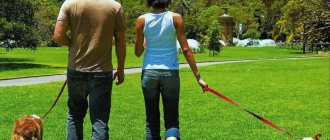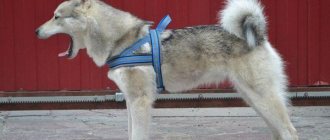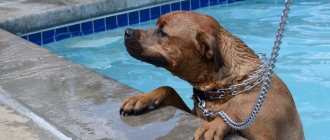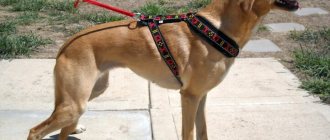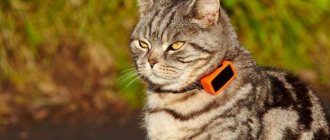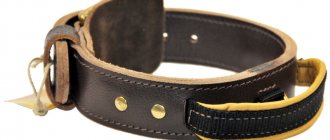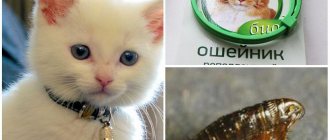There has been a debate among dog lovers for decades about which is better – a harness or a collar. Owners of French bulldogs and poodles, divers and Chihuahuas give many reasons in favor of each of these options. Therefore, it will be useful to understand this issue and list the main advantages and disadvantages of both solutions.
The husky is clearly happy with the harness
What to choose: harness or collar
In fact, it is impossible to say unequivocally which is better - a collar or a harness. If only because each of them has certain advantages and disadvantages. And the choice of the appropriate option depends on the strength of the owner, discipline and physique of the pet.
Curious ! Initially, harnesses were used as an element of equipment for sled dogs - they evenly distributed the load over the neck, shoulders and chest, so that the animals could run for a long time without losing their breath.
So you will have to choose the appropriate option in each specific case. And for this you will have to understand the issue in detail.
When should a dog wear a collar?
The collar is suitable during the “education” of the dog, for example, teaching the pet to walk nearby. When training obedience, it is worth choosing a product that provides better contact between the dog and the handler and the ability to correct the behavior and condition of the animal.
Collars are also better suited for larger, stronger breeds that are more difficult to handle. A harness does not give the owner enough control over a large, excited pet that becomes violent at the sight of a cat or other dog. Thanks to the collar, it will be easier to distract your four-legged friend's attention and direct it to something else.
How to choose a collar for a dog?
When buying a collar, be sure to know the neck circumference. The size of your four-legged friend also matters. The same principle applies here as when choosing harnesses: the larger the pet, the wider the accessory. We are talking about the correct distribution of pressure along the dog’s neck in the event that the animal begins to tug or drag the owner during a walk. A collar with a width of about 2 cm is suitable for small individuals, while for medium and large ones - from 2.5 cm to 4 cm and even 5 cm.
Thus, it is difficult to categorically answer the question, a collar or a harness - which is better for a particular dog. When choosing this accessory, we must remember that we are responsible for the comfort and safety of the pet. Therefore, it is important to pay attention to the material and workmanship. You should not buy things that at first glance do not seem very durable and reliable. For the sake of your pet, it is worth investing in good quality accessories that will provide him with maximum safety and comfort, regardless of whether you choose a harness or a collar.
Pros and cons of collars
First, we should talk about the advantages of collars. There are quite a lot of them:
- Low cost.
- They are often made from high-quality materials (for example, genuine leather).
- You can leave it on after walks by simply attaching the leash with a carabiner.
- Makes it easier to control large and strong dogs. If a dog breaks from the leash, it involuntarily squeezes its throat, after which it usually calms down.
- Can be used for a puppy from just a few months old.
But there are also certain disadvantages. The main one is the downside of the above-mentioned plus - a dog, pulling hard on the leash, may well damage its larynx or simply suffocate. This is definitely worth remembering.
Types of collars and their purpose
Arriving at a pet store, a new dog owner may be confused when he discovers a great variety of different collars. They make products from artificial and natural leather, synthetic materials, fabrics, and metals. In addition, there is a classification of collars, dividing them by areas of application.
Walking
Walking collar
Collars suitable for daily walking of your pet. They must be made of high-quality materials that are wear-resistant but do not cause discomfort to the dog - leather, leatherette, felt, nylon, etc. Collars made from combined materials can also be found on sale. A walking collar includes the following:
- strong connection with the leash (it is better if it is in the form of a solid welded ring);
- It is mandatory to have a soft pad on the inside of the product in contact with the animal’s neck.
For service and training
Training collars
For such purposes, ammunition is produced from materials of the highest quality. Such collars are equipped with a special handle that allows you to hold the animal at any time, and it also allows the owner to control the pet’s actions.
Most often, collars have two half rings or loops at the top. For work or training, it is more convenient to attach the leash to the ring located closer to the buckle.
To stand guard
Collar for guard duty
The equipment intended for leashed dogs also has its own peculiarity. The models have a decent width. It is better to give preference to products made from materials that are durable and wear-resistant, capable of withstanding any weather conditions and constant use.
When in use, the leash is threaded through the half ring, then the carabiner is attached to the buckle. This design allows the load received during tension to be transferred not to the dog’s neck, but to the buckle area.
Choke collar
Choke collar
Quite formidable ammunition, intended for no less formidable animals - representatives of large or fighting breeds with a wayward or even ferocious disposition. Naturally, in this case we are not talking about the aesthetics and beauty of the product.
Nooses can be made of leather or synthetic fabrics, but most often they are made from metal in the form of chain links. Such collars are used for walking, training and during participation in public events - competitions, exhibitions.
The impact of a noose from puppyhood (when the bitch pulls the babies by the withers, slightly squeezing) is associated with prohibition in dogs. Naturally, it is necessary to calculate the force and time of impact. If you do not have the skill to handle such ammunition, you should consult a dog handler.
When choosing metal products, you should be extremely careful:
- the collar must be made of durable alloy;
- the links of the chain must be well and firmly sealed so as not to scratch the animal’s skin;
- The most low-allergenic alloy is considered to be Kurogan (the color is slightly darker than brass with a reddish tint);
- For pets with light hair, it is extremely important that the collar does not stain the coat.
“Parfors” (in common parlance – “planer”)
Collar “Parfors”
Another type of equipment for dogs with a certain character. Its purpose is to use it in the learning process and training. Differences from other collars are the presence of spikes on the inside, which cause discomfort to the pet during strong jerks and when pulled.
When choosing a parfors, you need to focus on the length of your pet’s fur:
- For dogs with smooth and short hair, strict collars made of wire or plates are suitable.
- For long-haired pets, it is preferable to take a metal parfors.
A very important requirement is that the thorns should not injure the pet’s skin, cause severe pain, or have a targeted effect on the skin. Otherwise, the learning process will not give positive results. The parfors should not sit tightly on the dog's neck or be too loose. A strict collar implies the ability to adjust the product to the size of the pet, only by removing the extra links.
The "strogach" can be used only for its intended purpose - during the period of training and education. It is not suitable for constant wear, for daily walking and playing with other dogs.
Exhibition equipment
Show collar
Someone might think that the main thing here is beauty and aesthetics - the more rhinestones and glitter, the better. However, this is not quite true. Yes, aesthetics are important, but the accessory should not be flashy, distracting from the dog’s advantages. When choosing, you should focus on three properties - practicality, convenience and quality.
Owners of show-class pets should be aware that in order to participate in exhibitions, special collars are required - ring collars, used to guide the participant around the ring. This design combines two accessories at once - a collar and a leash.
There is a special provision of the RKF that prohibits the use of parfors harnesses for these purposes; ordinary collars, leashes and tape measures are also not used.
Decorative collars
Decorative collars
Such ammunition has more aesthetic value. Decorative collars are suitable for dogs of miniature breeds; they are less often chosen for medium-sized pets. The material and design are different, depending on the designer’s imagination.
When to use collars
When getting a large (diver, St. Bernard) or aggressive and strong (pit bull, bull terrier) pet, it is advisable to use a collar. If a poorly trained, young or simply excited dog begins to twitch too much, he will quickly feel a tightening on his neck and will be forced to calm down.
Collars are better for fighters
In addition, when walking puppies, it is also better to give preference to a collar. Without feeling the pressure from the harness, some may jerk so violently that they injure their back muscles or even their spine. Therefore, for young dogs (up to about 8 months), it is better to use collars.
What are the dangers of leash tension?
However, when using a collar, you should be aware of the possible danger - too strong jerks may well damage the dog's larynx or even lead to suffocation. Therefore, the dog needs to be trained as soon as possible. At least a few basic commands, like “Come to me!” and “Ugh!” she must know.
Pros and cons of harnesses
Of course, when figuring out which is better – a leash or a harness, you should look at the strengths and weaknesses of the latter. It has quite a lot of advantages. One of them is a reduced risk of the dog getting a neck injury from strong jerks. In addition, the dog will definitely not be able to pull out his neck, as when using a collar (especially important for dogs whose neck and head diameters are approximately the same). The load is evenly distributed over two wide belts, making the dog feel more comfortable.
High quality labrador harness
However, there are also disadvantages:
- High price.
- Difficulty in fitting – it is important to select a harness specifically for a specific dog. Even small assumptions will lead to the dog either constantly feeling discomfort or being able to jump out.
- The need to put it on the dog before a walk and take it off after it.
- Complicated control over the dog.
Note! It is better to use a harness only after eight months, when the dog has matured and become strong enough, and has also learned basic commands and follows them unquestioningly.
Collar or harness. What's better?
Collar or harness - which is better for a dog?
➤ Has a new four-legged family member appeared in the house? In this case, in addition to joy, concern also appears. After all, a dog requires certain care and protection. At home it’s easier in this regard, but on the street there are difficulties. To make your walks enjoyable and with a minimum of worry, you need to take care of special equipment - a collar with a leash or a harness. But what is better to give preference to, and what nuances should be taken into account when choosing?
❁ཻུ۪۪⸙Types of collars and their purpose
➤ Arriving at a pet store, a new dog owner may be confused when he discovers a great variety of different collars. They make products from artificial and natural leather, synthetic materials, fabrics, and metals. In addition, there is a classification of collars, dividing them by areas of application.
❁ཻུ۪۪⸙Walking
➤ Collars suitable for daily walking of your pet. They must be made of high-quality materials that are wear-resistant but do not cause discomfort to the dog - leather, leatherette, felt, nylon, etc. Collars made from combined materials can also be found on sale. A walking collar includes the following:
↷ strong connection with the leash (it is better if it is in the form of a solid welded ring);
↷ it is mandatory to have a soft pad on the inside of the product in contact with the animal’s neck.
❁ཻུ۪۪⸙For service and training
➤ For such purposes, ammunition is produced from materials of the highest quality. Such collars are equipped with a special handle that allows you to hold the animal at any time, and it also allows the owner to control the pet’s actions.
➤ Most often, collars have two half rings or loops at the top. For work or training, it is more convenient to attach the leash to the ring located closer to the buckle.
❁ཻུ۪۪⸙For guard duty
➤ The equipment intended for leashed dogs also has its own peculiarity. The models have a decent width. It is better to give preference to products made from materials that are durable and wear-resistant, capable of withstanding any weather conditions and constant use.
➤ When in use, the leash is threaded through the half ring, then the carabiner is attached to the buckle. This design allows the load received during tension to be transferred not to the dog’s neck, but to the buckle area.
❁ཻུ۪۪⸙Choke collar
➤ Quite formidable ammunition, intended for equally formidable animals - representatives of large or fighting breeds with a wayward or even ferocious disposition. Naturally, in this case we are not talking about the aesthetics and beauty of the product.
➤ Nooses can be made of leather or synthetic fabrics, but most often they are made from metal in the form of chain links. Such collars are used for walking, training and during participation in public events - competitions, exhibitions.
➤ The impact of a noose from puppyhood (when the bitch pulls the babies by the withers, slightly squeezing) is associated with prohibition in dogs. Naturally, it is necessary to calculate the force and time of impact. If you do not have the skill to handle such ammunition, you should consult a dog handler.
➤ When choosing metal products, you should be extremely careful:
↷ the collar must be made of durable alloy;
↷ the links of the chain must be sealed well and firmly so as not to scratch the animal’s skin;
↷ The Kurogan alloy is considered the least allergenic (the color is slightly darker than brass with a reddish tint);
↷ For pets with light hair, it is extremely important that the collar does not stain the coat.
❁ཻུ۪۪⸙“Parfors” (in common parlance – “planer”)
➤ Another type of equipment for dogs with a certain character. Its purpose is to use it in the learning process and training. Differences from other collars are the presence of spikes on the inside, which cause discomfort to the pet during strong jerks and when pulled.
➤ When choosing a parfors, you need to focus on the length of your pet’s fur:
↷ For dogs with smooth and short hair, strict collars made of wire or plates are suitable.
↷ For long-haired pets, it is preferable to take a metal parforce.
➤ A very important requirement - the thorns should not injure the pet’s skin, cause severe pain, or have a targeted effect on the skin. Otherwise, the learning process will not give positive results. The parfors should not sit tightly on the dog's neck or be too loose. A strict collar implies the ability to adjust the product to the size of the pet, only by removing the extra links.
➤ The "strogach" can be used only for its intended purpose - during training and education. It is not suitable for constant wear, for daily walking and playing with other dogs.
❁ཻུ۪۪⸙Exhibition equipment
➤ Someone might think that the main thing here is beauty and aesthetics - the more rhinestones and glitter, the better. However, this is not quite true. Yes, aesthetics are important, but the accessory should not be flashy, distracting from the dog’s advantages. When choosing, you should focus on three properties - practicality, convenience and quality.
➤ Owners of show-class pets should be aware that in order to participate in exhibitions, special collars are required - ring collars, used to guide the participant around the ring. This design combines two accessories at once - a collar and a leash.
➤ There is a special provision of the RKF that prohibits the use of parforce harnesses for these purposes; ordinary collars, leashes and tape measures are also not used.
❁ཻུ۪۪⸙Decorative collars
➤ Such ammunition has more aesthetic value. Decorative collars are suitable for dogs of miniature breeds; they are less often chosen for medium-sized pets. The material and design are different, depending on the designer’s imagination.
❁ཻུ۪۪⸙Recommendations for choosing a collar
➤ Experts recommend choosing equipment for your pet only after having the opportunity to try it on. Experienced dog handlers have various types of equipment at their disposal - for everyday walks, exhibitions, training and other events. They also advise other dog owners to do the same.
➤ Any equipment requires regular care - washing, cleaning, which will increase its service life and protect your pet from infection. Price is far from the most important criterion, since in pursuit of profit you can harm your four-legged friend. The pursuit of beauty is also inappropriate - rhinestones, rivets and other decorations can cause discomfort in the animal.
➤ To make it easier to determine the size, you can focus on the standard - two fingers should fit freely between the animal’s neck and the product. To protect the animal's fur, it is better to choose ammunition with protective valves.
➤ The choice of collar is made based on the breed:
↷ For those with a hard coat, it is better to choose collars that have a leather inner surface, a circular cross-section and external seams.
↷ Large, active dogs with a violent temperament are best bred with a strict collar.
↷ For pets with long, silky hair, a chain collar made of chromed metal is more suitable.
↷ To protect an overly curious and disobedient pet during the educational process, it is recommended to use a choke collar.
↷ Lightweight leather or fabric collars equipped with a valve that protects the skin and fur from contact with metal parts are suitable for puppies.
❁ཻུ۪۪⸙Harnesses: features and advantages
➤ Another type of equipment for dogs, including belts and straps. Today it is a fairly popular product that has a number of advantages. And, above all, the harness removes the load from the animal’s cervical vertebrae, distributing it to the shoulder and thoracic regions.
➤ During their appearance, they were used as dog harnesses. To this day, there is a special type of harness used in the north for sledding, as well as for sports racing. The designs of these products have some differences from conventional harnesses; they are made of very strong materials - canvas or nylon fabric.
➤ Special ammunition is also produced:
↷ to move along the trail;
↷ harnesses with weights for correcting the muscle corset;
↷ equipment for guide dogs;
↷ harnesses for medical purposes and others.
➤ When choosing a harness, you should be guided by the following recommendations:
↷ The most important parameter when choosing is the size of the ammunition. There should be a snug fit without pressing into the dog's skin;
↷ the harness should not restrict movement.
↷ Harness fasteners should not have sharp edges or protruding parts.
↷ Correct fit of the equipment is when the side strap is not pressed against the pet’s armpits. For representatives of large and medium-sized breeds, the distance is the width of the palm of an adult; for small dogs, 2-3 fingers are enough.
➤ The advantages of harnesses include the following:
↷ a pet wearing a harness does not feel discomfort;
↷ easy to use.
➤ The disadvantages are that the dog quickly gets used to it; after wearing a harness, the pet may refuse to wear a regular collar. Not suitable for all breeds. When you get home, you must take off the harness. In the process of training, a harness will not help much, since pulling it back will not have the desired effect on the dog.
❁ཻུ۪۪⸙Which is better: harness or collar
➤ Despite all the advantages and disadvantages of collars and harnesses, the pet owner must take into account various additional factors:
➤ To make the right choice, you need to understand a little about dog equipment and its purpose. No matter how good a harness is, it will not be the best option for a St. Bernard. A good, strong collar will be more relevant here. In addition, for some breeds, such as dachshunds, experts do not recommend their use at all. And for miniature pets, for example, toy terriers, chihuahuas, a harness is the most successful option, as it puts pressure on the fragile cervical vertebrae and is an appropriate decoration for the dog. The same applies to representatives of breeds with short muzzles - pugs, French bulldogs, etc. A dog living in an apartment has completely different needs than an animal performing guard duty on a chain.
➤ Many veterinarians and dog handlers believe that the collar has a detrimental effect on the pet’s cervical vertebrae. As for the choice of a harness or collar for puppies, the opinions of experts are divided. Most still recommend refraining from wearing a harness until the bone corset is strengthened - up to 8-10 months. The larger the pet, the longer its skeleton grows and develops.
➤ There is also no consensus on whether constant use of a harness is beneficial, since the animal develops a different center of gravity. So, you need to evaluate the pros and cons and make a choice in favor of your pet.
When to use harnesses
It’s worth saying right away that for small dogs such as Spitz, Dachshund, Corgi, Yorkie and Jack Russell Terrier, it is better to use a harness. The fact is that these animals have a rather weak structure, the reason for which is thin bones and low muscle mass. Often, one unsuccessful tug on the collar is enough to cause serious injury to your pet.
Remember ! A well-trained dog does not need a harness, and a collar is needed primarily for the peace of mind of those around him. Therefore, quality training is a mandatory step in keeping a pet.
A harness can be used if the dog is a hunting breed (terrier, Labrador) or fighting breed (Staffordshire terrier, pit bull), but is well trained and is already about a year old. The main thing is that the process of getting used to the new accessory is painless.
Finally, it is better not to use a collar for huskies, huskies, malamutes and other sled dogs; harnesses are much better suited. The reason is the special structure of the skeleton and the distribution of muscle mass - they feel more comfortable and confident in a harness.
Harness: advantages and disadvantages
Wearing a harness creates the illusion of freedom, since the load is distributed evenly throughout the animal's entire body. In addition, the following advantages of the harness are highlighted:
- wide selection of colors and models;
- suitable for any breed;
- does not injure the animal.
A properly sized harness will not cause discomfort to the dog during walks. However, this walking attribute has some disadvantages. An insufficiently trained dog is difficult to control if it is in a harness. It is also not recommended to wear a harness on large fighting breed dogs. If the dog is in a harness, it will be almost impossible to stop him from jumping on a person. In addition, a good harness costs about five times more than a collar.
What types of harnesses should you avoid?
When the breeder has decided what is best for his pet - a harness or a leash, he can move on to the next step. Namely, the choice of harness. It turns out that not all of them are comfortable and safe for dogs. An unsuccessfully chosen accessory may well cause serious harm to your pet.
Many veterinarians criticize restrictive harnesses. The fact is that in them the belt crosses the shoulder joint, preventing the dog from moving its front paw forward when walking. She is forced to change her pace to experience less discomfort. As a result, even when the harness is removed, the dogs experience discomfort and continue to walk at an already practiced, not very comfortable step.
